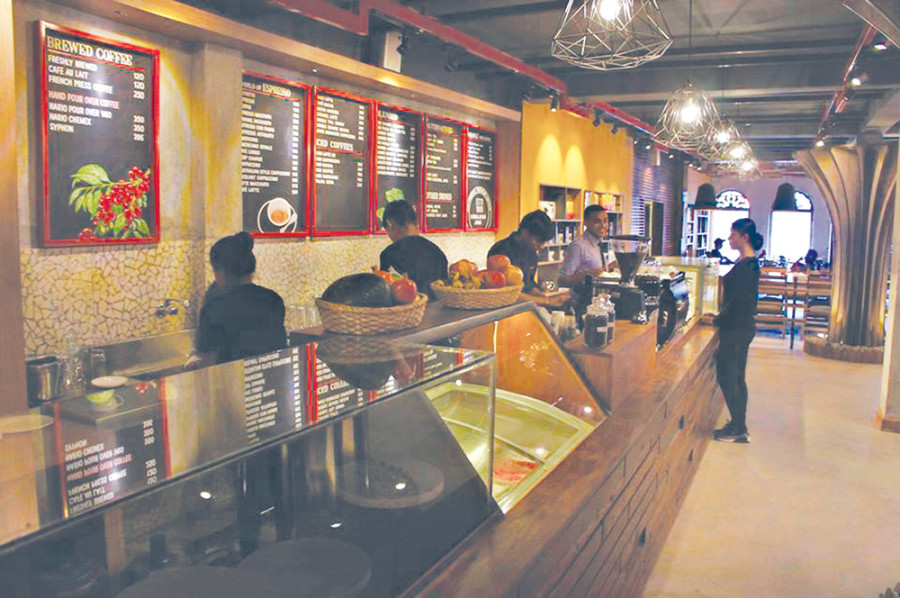Entertainment
Build more than just brands, forge new cultures
How Himalayan Java created not just a lucrative and well-recognised brand but an entirely new lifestyle
Shaleen Shah
Two men walk into a Nepali coffee shop in Washington, DC. One of the men notices that the table has a broken leg and it is supported by a polished brick. He comments to the other man that it should be fixed, but little did he know that the oddity was placed there on purpose. Why? To increase the coffee shop’s overall ‘Nepali’ feel. This is, reportedly, a true story. According to Himalayan Java’s founder Gagan Pradhan, such artistic quirks are intrinsic parts of coffee shops.
Recently, Nepal’s coffee shop industry has seen uncharted growth. According to Pradhan, there are more than 100 espresso machines within a two km stretch of road in Pokhara; Kathmandu now has more coffee shops than DC and it is almost comparable to Seattle, the coffee capital of the United States. Just 15 years ago, coffee was considered an obscure and alien, food and beverage outlets would put it under low priority, preferring tea instead. Now, coffee is on top of their lists.
In order to understand the popularity of coffee shops one has to dig deeper into what coffee shops offer to its customers. Pradhan remarks that idiosyncrasies such as a broken table stood up by a brick play a huge role, explaining that coffee shops not only just sell coffee. They strive to provide the customers with something extra and more valuable—an experience, and an atmosphere.
Tristan De Montebello, an entrepreneur and coffee enthusiast based in Venice, California, carried out a simple experiment. He asked everyone in a Venice based coffee shop, the Deus Ex Machina, what they were doing at that exact moment. The result was astounding—he found writers, musicians, designers, photographers, students, and tech employees working on various projects and all of them said that the environment helped them focus.
Himalayan Java has similar offerings. Pradhan reports that he meets various people who admit that they come to the shop for the richly-themed environment, which the artistic quirks help enhance,
rather than just for the coffee. “What coffee shops sell is an experience—friendly servers, smiley faces, other interesting people, artistic quirks, comfortable couches—they are all part of the picture. A coffee shop would lose its essence and become barren without them. Coffee is simply an addition, a cherry on top to what coffee shops offer.”
The current popularity of coffee in Nepal was not always so prominent. It was on November 28, 1999 that the first coffee shop (an outlet
dedicated solely to coffee) in Nepal—The Himalayan Java—opened. The response of people was quite lukewarm to the new beverage then, Pradhan says. Most of the customers would arrive at the door expecting a computer institute (because of the word java, which is also a programming language), and later would condemn Pradhan of being sly and luring people into his shop with a computer-esque name. Others would come, be dazzled by the then unorthodox, artsy atmosphere and order an espresso, amused by the appealing name. When they received a small cup of dark, bitter coffee, they would storm out, cursing the café for charging Rs 60 for such a measly drink.
The first few years of running the business were torturous, Pradhan professes. The café moved to Thamel (where it still stands). Only westerners would visit the café and praise them for the coffee and the similar environment they were so familiar with in their home countries. Nepalis would avoid it, labelling it as overpriced and redundant. The café was largely at loss, due to the misalignment of western and eastern tastes. But then, in 2002, a Eureka moment hit Pradhan.
One day, Pradhan was observing old Nepali men with dhaka-topis sitting under a tree, sipping tea and conversing. “Then it occurred to me, it wasn’t the tea these men were interested in,” Pradhan would later say “It was the environment, the sense of community, of belonging. Tea was just a medium.”
In 2002, during the FIFA World Cup, Himalayan Java purchased a 50 inch TV and installed it on their wall. At a time where food outlets and bars didn’t have TV screens featuring sports, this was a new concept. People would, reportedly, come in at night and curious visitors would follow, wondering what all the fuss was about. Around 300 customers started visiting the café every day, as opposed to just 30 or 40.
At the time, when restaurant hierarchies were omnipresent, dealings between customers and workers were strictly official and impersonal, waiters and cooks were just peons who did all the work and managers wouldn’t touch a single thing, Pradhan would work at the coffee shop himself as the barista, receptionist, waiter and manager exchange-ably. This earned him criticism and the label of a “greedy owner.” However, as he and other workers at Java made an effort to share friendliness and warmth with the customers, the criticisms and labels faded. Slowly, a new culture was born.
“It was a historic time for Java,” Pradhan reminisces “The coffee shop came alive. It was finally fulfilling its intended purpose—bringing people together.” Java changed their motto to “Coffee over Conversation forms a Community”, which confused customers at first, but it caught on as they began to understand its meaning.
Today, the popularity of coffee is off the charts, at first glance. However, Pradhan argues that if one looks closer to find what makes coffee popular, it is not the coffee, but the culture. “So, you still haven’t why specifically the DC coffee shop owner put a brick under the table,” I asked Pradhan, towards the end of our conversation.
“When you run out of topics to talk about in a coffee shop, just look around. You’ll find plenty,” he replied, sipping a cup of caffè latte.




 14.12°C Kathmandu
14.12°C Kathmandu










